IT Band Connections
At the top end the IT Band connects to the crest of the pelvis.
It connects to the iliac crest where the pelvis is widest from side to side.
A deeper layer of the IT band connects to the side of the hip bone near the hip socket. This deep layer does not connect to the Tensor Fascia Latae or Gluteus Maximus.
At the bottom end it attaches to the top of the tibia close to the outer edge of the knee-cap.
You could think of this lower attachment as being at the front-outer corner of each knee, if looking down from above at your own knees.
The IT Band and Single Leg Hip Stability
Standing with body weight centered on one foot and the knee straight, (and focusing on the IT band of this "weighted" leg), if the shin of that leg is stabilized against rotation:
- Then the IT band can be used to help prevent the pelvis from tipping towards the non-weighted side.
- It could also be used to lift that side of the pelvis or allow it to lower with control.
The word "help" is used because the gluteus medius and gluteus minimus can also help in these actions.
The Gluteus Medius and Minimus
The Gluteus Medius and Gluteus Minimus also have attachment points close to the crest of the pelvis. Their other attachment point is to the top of the thigh bone at the greater trochanter.
Where the Gluteus Medius and Gluteus Minimus require a stable thigh in order to help stabilize the pelvis, the Tensor Fascia Latae and Gluteus Maximus (superficial fibers) need a stable lower leg.
The IT Band as an External Leg Rotator
With weight even on both feet we could model the pelvis as the stable or-non-moving point to which the IT bands attach.
If you're not sure about standing with weight even on both feet, try moving from side to side.
Get a feel for how this affects the pressure ratio between the feet.
Then see if you can find the position where pressure is even in both feet.
With the pelvis stable, any added tension to the IT band can be used to create an external rotation force at the tibia.
This is because the iliotibial tract connects towards the front of the top of the tibia.
Straight Knee vs Bent Knee Shin Rotation
When the knees are straight the lower and upper leg rotate together as one unit.
When the knees are bent, the lower leg can rotate slightly with respect to the thigh.
Standing with knees straight, tension added to the IT band can cause the thigh and lower leg to externally rotate together.
Standing with knees bent, adding tension to the IT band can cause the lower legs to rotate slightly with respect to the thighs. At the same time, the knees may also be pulled outwards.
The Sartorius, Gracilis and Semitendinosus as Internal Leg Rotators
With legs straight and IT band activated, external rotation may or may not happen. It depends on the forces that oppose the external rotation force transmitted by the IT Band.
This opposing force may come from the combination of the sartorius, gracilis and semi-tendinosus muscles, all of which attach to points of the pelvis and all of which share an insertion, whose latin name, is translated as "goose foot", on the inside edge of the tibia just above where the tibia narrows below the knee joint.
Sartorius connects from the Tiba to the front of the iliac crest at the ASIC (Anterior Superior Iliac Crest).
Gracilis attaches to the pelvis near the pubic bone.
Semitendinosus, one of the hamstring muscles, attaches to the pelvis at the Ischial Tuberosity or Sitting Bone.
If these three muscles are activated and create an equal force of internal rotation then the forces generated by the two sets of muscles will balance each other resulting in a shin that is stabilized against rotation in either direction.
Since all of these muscles also attach to the pelvis at key points of leverage , the pelvis is also stabilized.
The ratio of forces could be varied to create stabilized internal or external rotation of the shin and thigh.
With the shins stable, different combinations of activations of all of these muscles (Sartorius, Gracilis, Semitendinosus, Tensor Fascia Latae and Gluteus Maximus) can be used to help tilt the pelvis forwards or backwards.
Resisting Gravity-Driven Internal Rotation with the IT Band
When the legs are relaxed (or as relaxed as possible while still staying upright) the tendency is for the inner arches of the feet to collapse so that the shins roll inwards.
Tension in the IT band can be used to help resist this tendency.
In this case the internal rotators might not be active. However, tension in the IT band could be increased without causing further external rotation by also activating the internal rotators.
The IT Band and the Vastus Lateralis
So far the focus with respect to the IT Band has been mainly on the tensor fascia latae and external fibers of the gluteus maximus.
This article about the Anatomy of the lateral retinaculum of the knee mentions a connection between fibers of the vastus lateralis (the outer head of the quadriceps muscle) and the IT band at the lower end of the thigh, near the knee.
Activation of the vastus lateralis can thus add tension to the lower end of the iliotibial tract. This may happen with or without tensor fascia latae activation. It may also happen with or without gluteus maximus activation.
As an interesting aside, a portion of the vastus lateralis attaches to the back fo the thigh bone just below where the deep portion of the gluteus maximus attaches.
Another way in which Vastus Lateralis can add tension to the IT band is via the muscle expansion that occurs when it activates. This can add tension to the IT band by pushing out against it.
Bearing in mind the aforementioned relationships between the Vastus Lateralis and the IT band, activation of the Vastus lateralis could be used to press out against the IT band to add tension and at the same time create pull upwards on the IT band where it attaches to the Tibia. In this way vastus lateralis activation is more likely to affect the IT band at the knee joint, and perhaps not so much at the pelvis.
Shin Rotation and How It Affects the Shape of the Foot
Rotation of the shin with the foot on the floor tends to cause the shape of the foot to change.
Assuming that the heel and base of the big toe remain in contact with the floor:
- External rotation of the shin tends to increase the height of the inner arch and also shortens the distance between the base of the big toe and the heel.
- Internal rotation of the shin tends to flatten the inner arch and increase the distance between the base of the big toe and heel.
Shin rotation can actually be driven by foot actions so that changing the shape of the foot drives internal or external rotation of the shin.
In this way the foot and ankle muscles could be used to help stabilize the shin against rotation.
Bent Knee Shin Rotation and the IT Band
In Warrior 1, the front knee is bent and the back knee is straight. Focusing on the front leg, you could stabilize the front foot so that the shin is stabilized against rotation. The muscles that act on the IT band could then be used to help control and stabilize the pelvis along with the internal lower leg rotators.
Assuming the pelvis is stabilized, the muscles that work on the IT band could be used to add external rotation tension to the IT band. This action could externally rotate the shin which would affect the shape of the foot, causing the inner arch to lift. The base of the big toe could then be pressed down into the floor, the muscle causing this action being given a stable foundation, and room to move, by the external rotation of the shin.
The actual amount of external rotation could be adjusted by either modulating Tensor Fascia Latae and Gluteus Maximus activation, and/or by using the internal rotators.
Moving the Knee Out Using the IT Band
If the knee joint is acted on in such a way that rotation of the shin relative to the thigh is inhibited:
- Then added tension to the IT band could be used to move the knee outwards.
- Tension added to the internal rotators could be used to move the knee inwards.
- Dual activation of both sets of muscles could be used to help prevent the knee wobbling from side to side
Going back to Warrior 1, the muscles that act on the IT band could be used to move the knee outwards or, acting against the internal rotators, keep the knee stable.
Revisiting Straight Knee Leg Rotation
Focusing on the back leg in Warrior 1, assuming the foot is flat on the floor, then the IT Band muscles could be used to help externally rotate the leg, helping to lift the inner arch of the back foot. Or, assuming the foot is stabilized with the arch lifted, the lower leg could act as a foundation from which the IT band muscles can act on the pelvis, helping to adjust the position of the pelvis, and then potentially being used to stabilize it against further movement.
Muscle Specific Internal and External Shin Rotation via the IT Band
Returning to a standing position with knees straight, the tensor fascia latae could be used to internally rotate the shin relative to the pelvis.
The gluteus maximus fibers that attach to the IT band could be used to externally rotate the shin relative to the pelvis.
With weight on one leg with the knee straight and other foot lightly touching the floor or completely lifted, the weight bearing foot is ideally active and stable, with the shin resistant to rotation.
The IT band then has a foundation from which to control and stabilize the pelvis.
In this scenario the internal rotators that attach to the inside of the shin could be relaxed or active.
To keep the pelvis rotationally stable, the tensor fascia latae and gluteus maximus could work against each other.
- In this case the tensor fascia latae tries to rotate the pelvis towards the weight bearing side (the equivalent of an internal rotation of the thigh).
- The gluteus maximus tries to rotate it away from that side (equivalently an external rotation of the thigh).
If the pelvis is stable, tensor fascia latae activation could internally rotate the leg relative to the pelvis, closing the front of the hip. However, if the leg is stable then tensor fascia latae activation would rotate the pelvis to close the front of the hip.
Dealing with IT Band Issues
When dealing with Iliotibial band issues (knee pain or hip pain) one problem may be a lack of pelvic stability. Pelvic stability can come from the hip muscles, stabilizing it relative to the thigh, or from spine and abdominal muscles, stabilizing the pelvis relative to the ribcage and spine.
With a stable pelvis the tensor fascia latae and gluteus maximus can act on the IT band to affect the tibia.
Another problem may be a lack of lower leg rotational stability. This could come from a heel and ankle that collapses, or from a week inner or outer forefoot.
Since the muscles that work on the IT band can work in concert with the Sartorius, Gracilis and Semitendinosus, any lack of function in these muscles can affect the IT band. And so a balanced practice to help fix (or prevent) IT Band problems can include stretching and strengthening both the inner thighs and the outer thighs.
What may be even more beneficial is learning to control these muscles. That means learning to activate and relax them while doing a variety of yoga poses and at the same time learning to feel them.
Useful Tips Based on Understanding IT Band Anatomy and Biomechanics
The Tensor Fascia Latae can act as a hip flexor. So that it can be used as a hip flexor it may be helpful to activate vastus lataralis. Basically, engage the side of the thigh. This can add tension to the IT band making it easier for the Tensor Fascia Latae to help flex the hip.
A similiar effect may be observable with the Sartorius. Since this muscle passes over the vastus medialis, activate vastus medialis to help add tension to sartorius, and it to may then help to flex the hip.
You could try this in yoga poses like those shown below.
If you can activate your vastus muscles at will, you can test this out for yourself.
Note, when dealing with IT Band Knee Pain, it helps to understand the lower connective tissue connections of the IT band to the tibialis anterior and peroneus longus.
Published: 2020 08 05
Updated: 2017 12 01
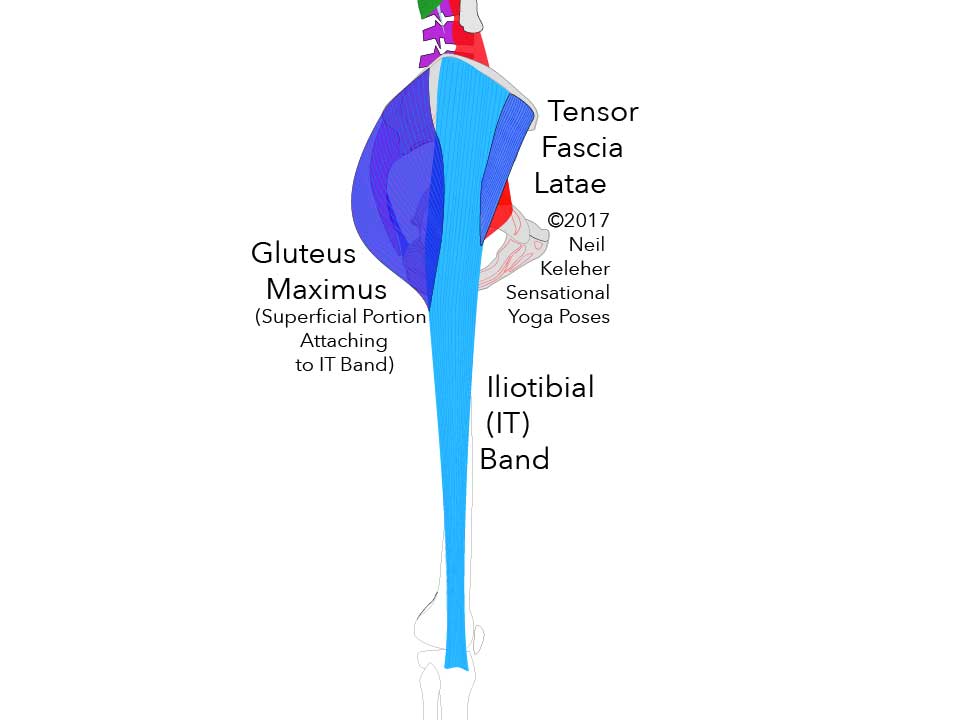
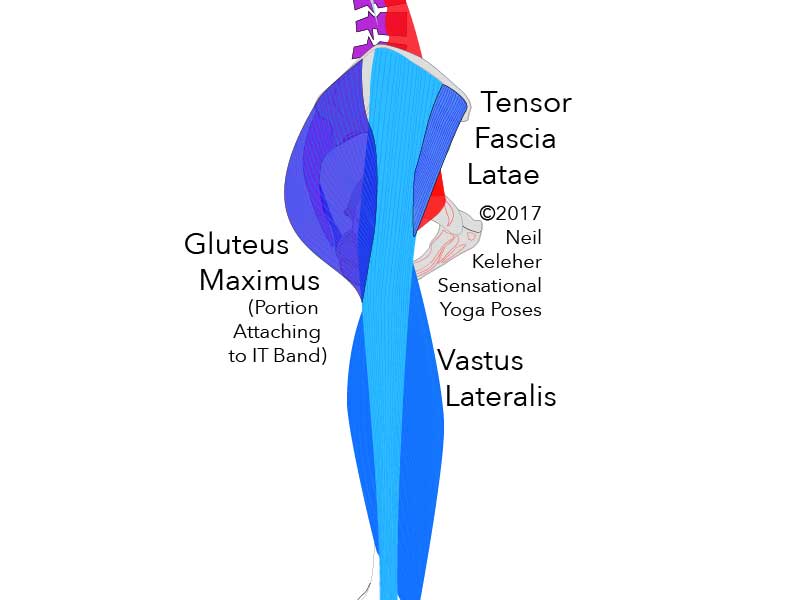
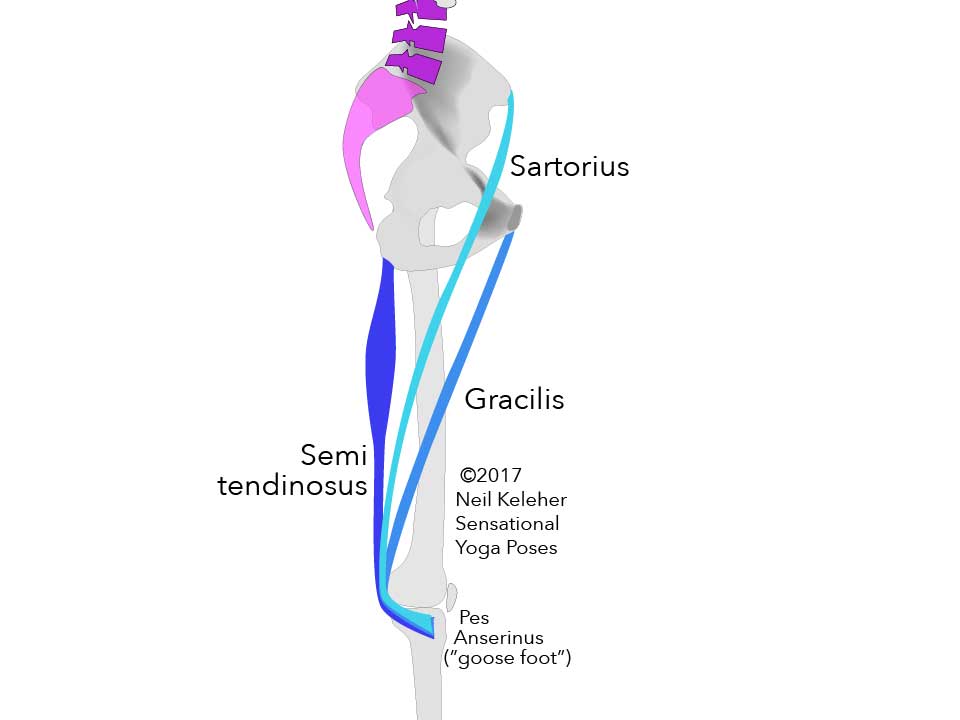
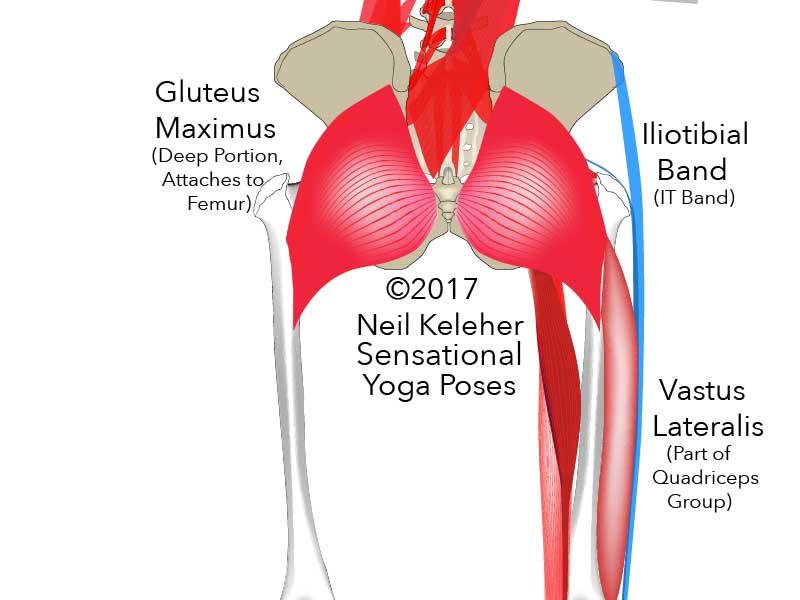
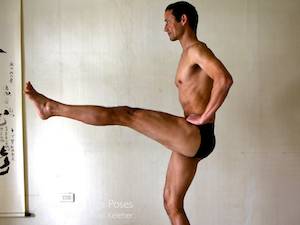 Standing Hip Flex
Standing Hip Flex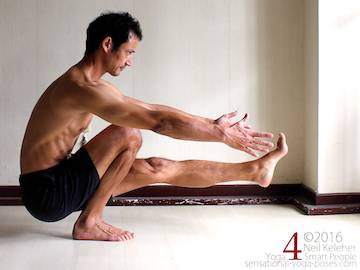 Pistol Squat
Pistol Squat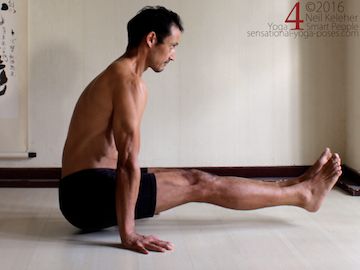 L-Sit Lift Up
L-Sit Lift Up

